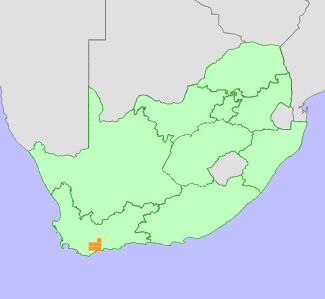|
Scientific Name | Gibbaeum hartmannianum Thiede & Niesler |
Higher Classification | Dicotyledons |
Family | AIZOACEAE |
National Status |
Status and Criteria | Vulnerable A2b; C1+2a(i) |
Assessment Date | 2023/08/22 |
Assessor(s) | D. Raimondo & O. Curtis-Scott |
Justification | A range-restricted endemic to the Eastern Overberg region of South Africa, this species has an extent of occurrence (EOO) of 1139 km² and an area of occupancy (AOO) of 68 km². Between 15 and 20 subpopulations are known, and the overall population is estimated to have fewer than 10 000 mature individuals, with no subpopulation recorded to have more than 500 mature individuals. The population has declined by between 30 and 50% over the past three generations due to livestock overgrazing, trampling, and habitat transformation for wheat cultivation. Therefore, it qualifies for listing as Vulnerable under criteria A and C. |
Distribution |
Endemism | South African endemic |
Provincial distribution | Western Cape |
Range | It occurs in Lower Breede River Valley, in the Swellendam region, Western Cape Province, South Africa. |
Habitat and Ecology |
Major system | Terrestrial |
Major habitats | Eastern Ruens Shale Renosterveld, Central Ruens Shale Renosterveld, Swellendam Silcrete Fynbos |
Description | Plants are found in white quartz patches overlying shale. This slow-growing dwarf succulent has a generation length of between 25 and 30 years. |
Threats |
| The majority of subpopulations occur on private land used for livestock farming. A survey of all suitable habitat for this species in 2012 found that it was absent from 44% of sites where it should have occurred (11 out of 44 sites surveyed), and these sites had been heavily grazed. As a dwarf succulent, it is sensitive to the impacts of trampling from livestock. Additionally, some historically recorded subpopulations have been lost to the cultivation of wheat. |
Population |
The population has experienced a decline of between 30 and 50% since 1960 due to the impacts of wheat and livestock farming. Seven of the 15 recorded subpopulations have population numbers recorded from recent inventory work. From these, the majority of subpopulations are small, with fewer than 50 mature individuals, and only a few have up to 500 individuals. However, more data is required to determine if the population would qualify as being severely fragmented.
|
Population trend | Decreasing |
Bibliography |
Thiede, J. and Niesler, I.M. 2012. Taxonomy of the genus Gibbaeum (Aizoaceae) and clarification of the confusion around Gibbaeum haagei, with a new species Gibbaeum hartmannianum. Haseltonia 18:34-44.
|
Citation |
| Raimondo, D. & Curtis-Scott, O. 2023. Gibbaeum hartmannianum Thiede & Niesler. National Assessment: Red List of South African Plants version 2024.1. Accessed on 2025/11/01 |
 Comment on this assessment
Comment on this assessment


